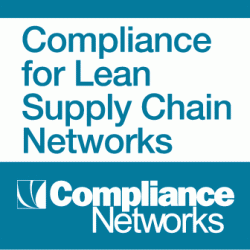 |
May 31, 2013 - Supply Chain Newsletter |
 |
| FEATURED SPONSOR: COMPLIANCE NETWORKS |
 |
Lean Freight Performance Via Timely Freight Post-Audits, Green Benefits, Retail Supply Chain Special Reports and more
|
 |
|
||||||||||||||||||||||||||||||||||||||||||||||||||||||||||||||||||||||||
Trip Report: Gartner Supply Chain Executive Conference
|
|||||||||||||||||||||||||||||||||||||||||||||||||||||||||||||||||||||||||
| GILMORE SAYS: |
"The bottom line, Phillips said, is that not only is there an imperative to sync the digital and physical worlds, but that the supply chain is extending further down, past the store level, in many ways." WHAT DO YOU SAY? |
Gartner has a huge conference business overall, and has basically adopted its overall model to this supply chain event. That has led to growth in attendees - some 1100 this year - and frankly a bit more commercialism, including a trade show type area and breakout sessions paid for by sponsors, elements that weren't there under AMR. But all told this conference is evolving into a major event status from the somewhat more "boutique" feel under AMR.
There were no real overall themes here, so I am going to jump right into keynote and breakout session highlights.
I was actually not expecting much from the Day 1 keynote by John Phillips, SVP of Customer Supply Chain and Logistics for PepsiCo. The titled indicated it was about social media and I assumed mobility and other topics that I have heard repeated times and which frankly often don't seem too connected to the supply chain.
I was wrong. Phillips did an excellent job of detailing a number of developments on the "digital" side of business and why connecting that digital world to the physical supply chain world is going to be increasingly important, pointing out many developments on the digital side I wasn't aware of.
Case in point: Pepsi now has a social media command center that monitors developments in this world closely, especially after new product introductions. This is a new age form of "demand sensing," and allows Pepsi to rapidly adjust forecasts and marketing plans based on trends seen in these social channels.
Virtual store technology is coming, Phillips showed, in which consumers can walk the aisles of local stores and put items they want in their shopping carts. This is a much different experience from the un-visual approach of on-line grocery shopping to date, and I think could transform the industry. There are the same type of opportunities for in-store promotions, end caps, etc. as in a real store. In Japan, there is such a system right in its subway system, where a shopper leaving the city can do this sort of virtual shopping and then have the groceries ready for pick up when she arrives home.
In the UK, a company has developed a secure home delivery system, basically a sliding drawer into which a delivery person would place dry goods, slide the drawer back in and then locking it. There was much more.
Phillips spoke of the challenges of maintaining data integrity across all this, something I have pondered myself many times, but I had not considered the packaging aspects. If I see an image or order from a virtual store that uses one packaging configuration, am I a little leery if the item I received looks different? This could be a huge challenge - packaging consistency and synchronization with the digital world.
The bottom line, Phillips said, is that not only is there an imperative to sync the digital and physical worlds, but that the supply chain is extending further down, past the store level, in many ways.
Does any of this apply to companies outside consumer goods to retail? I think so - more soon.
Intel manufacturing executive Robert Bruck gave a convincing presentation on the need for deep supplier collaboration, at least in Intel's case. The technology giant simply cannot meet its supply chain and product goals without suppliers moving a long down the same path at the same pace.
It has a supply chain engineering team that works with vendors across and down its tiers to make sure that happens, including companies it has no direct relationship with. But those companies may need to make improvements on their own to support say a goal to reduce production cycle time by 50%, which the company has achieved since 2009.
To get there, Intel also makes long term commitments to suppliers relative to relationships and volumes, and has over 130 joint ventures with suppliers (i.e., Intel has invested money) to drive innovation. Very different mindset than most companies.
L'Oreal's VP of corporate supply chain Barry Stewart and colleague Bin Zheng gave an interesting presentation on another form of supplier collaboration, but what intrigued me at the outset was how L'Oreal thinks about its supply chain. Its three-step model is: Plant -> Market -> Customer. Under Customer are processes such as demand planning, order-to cash-cycle, and trade services. Under Market are areas such as S&OP, and distribution requirements planning. Very interesting way to organize supply chain thinking.
After laboring under very manual processes for interaction with suppliers, L'Oreal a couple of years ago adopted a new collaborative platform (E2Open) that automated many of the existing steps, but more importantly allows L'Oreal and its 700+ vendors to share and see demand and supply response capability in real-time. It has cut days out of the cycle, and enabled L'Oreal's supply chain to respond much faster as data comes in relative to new product introduction. This is the type of integration and blurring of planning and execution we have been writing about for the past three years.
I was pleased to see Colgate-Palmolive and supply chain exec Mark Vollrath speak on Colgate's multi-year journey to standardizing manufacturing processes across the globe. That's because of all the major consumer packaged goods companies, I would say Colgate is the most reticent about what it is doing in its supply chain, which was sometimes taken as meaning that they weren't doing much.
The benefits of such standardization seem obvious today, but I liked Vollrath's observation now that when the manufacturing teams get together, personnel from different plants get together to solve a challenge, etc., they are now all speaking the same language, and referencing the same KPIs, greatly improving effectiveness.
Gartner analyst Simon Jacobson used the good analogy that it used to be each plant was sort of its own universe, whereas now the global supply chain is the center of the universe, with plants orbiting around that as satellites. If you haven't vigorous started this process yet, please do so with urgency.
Troy Roesslein of Sears Home Services - repair services and parts for appliances and such - gave a nice presentation that put some meat on the supply chain visibility bones. Until the past few years, Sears really had little visibility to inventory across its multi-tiered supply chain, which includes master DCs, regional DCs, repair centers, the vans of 7600 field service techs and more.
Sears has largely solved that now (still in progress) with a set of new tools (Softeon) that provide real-time, multi-level visibility right down to treating the vans as mobile warehouses. Total network inventory levels have dropped significantly as a result. Key to getting the field techs to buy in: having big part of total compensation be on the percent of calls completed in the initial visit. That made the techs realize importance of having the right parts on their trucks. The new system also has very interesting logic as to how parts that need moved or returned flow back through the network (reverse crossdocks).
Ok, I am out of room. Much more at the event, some of which is covered in our video review, others that we will write as case study articles in coming weeks.
Any reaction to Gilmore's summary of the Gartner conference? Were you there? What are your thoughts? Let us know your thoughts at the Feedback button (email) or section (web form) below.
![]()
| View Web/Printable Version of this Page |
|
|
|
YOUR FEEDBACK
Some good Feedback on our recent First Thoughts piece on A Unified Theory of Out-of-Stocks, in which SCDigest editor Dan Gilmore ponders on the OOS problem that never seems to go away.
That includes our Feedback of the week from Andre' Martin - who just happened to create the concept of Distribution Requirements Planning (DRP) more than three decades ago. More next week.
Feedback of the Week - On Unified Theory of Out-of-Stocks:
The Out-of-Stocks problem in the CPG Industry has been around a very long time and will not go away until we completely change our thinking on how to manage the end to end retail supply chain. First, we need to acknowledge some basic truths learned the hard way: 1. The retail store is the beginning & the end of the retail supply chain. It's the beginning of information flow and the end of product delivery. Having wrapped our brains around these basic truths we then need to take advantage of major breakthroughs that have occurred recently. Today, it is possible for a retailer and a manufacturer to model and connect their retail supply chain inside a single computer and drive it, end to end, from a unique store level sales forecast. Today, it is possible to resynchronize every node making up a retail supply chain every day based on changes in store level consumer demand and thus completely eliminate the "Forrester Effect" (also called the Bullwhip Effect). Today, it is possible for a retailer and a manufacturer to use this model of their retail supply chain and manage it as if one company were managing it. Today, it is possible for a retailer and a manufacturer, using this "business model, to create an Integrated Business Plan, identify gaps and take corrective action while there is still time. Today, there are no secrets anymore on how to manage the end to end retail supply chain, from the store to the factory, and significantly lower store out-of-stocks as well as reduce retailer's and supplier's inventories and operating cost at the same time. Today, it is possible to achieve a 99.8% On Shelf Availability (OSA) at the store while reducing overall supply chain inventory buffers at the same time. Today, there is a proven and well documented business process, and enabling technology, to actualize all of the above and it even has a name: It is called "Flowcasting the Retail Supply Chain."
Editor's Note: Martin invented the concept of Distribution Requirements Planning in the 1970s.
|
||
| Unified Theory of Out-of-Stocks: | ||
I am a self-proclaimed retail junkie and unfortunately for my wife salivate at the topic of OOS. I firmly believe that some retailers can capitalize on the OOS with behavior modification, especially soft line retailers. E.g. The Banana Republics or similar when faced with OOS situation can promise to ship the item for free to the consumer. Yes, they might incur some additional costs, but at least they will not lose the sale. Retail statistics indicate that the big box stores and malls in general are going to facing a decline in foot traffic due to increasing online sales, so in order exist they will have to begin to transition their customer and staff towards a greater online presence. Raj Daniels |
||
| Really appreciate your article on this subject as we have been researching and working this problem at Clemson University in our model factory since the late 90's. Our original R&D work and proof of concept solution was funded by the Department of Defense. A small group of us has formed a spin-off company to continue the perfection of the solution and make it available beyond the DoD. The Army has successfully used the solution for all combat apparel since 2005 and three commercial companies have also had great success with it. Our approach is a SAAS tool that synchronizes consumer demand through distributors and manufacturers up as many tiers of the extended supply chain as we can get to work together (and getting two or more companies to work together in a different manner is extremely difficult). We achieve synchronization based on the simple concept that everyone who orders replenishment, determines what to ship in VMI situations, or schedules production should order, ship, or make next that which is in shortest supply downstream of their location in the supply chain. We do this by creating standard structured "supply chain sections" throughout the supply chain as basic, but very flexible building blocks that use the same algorithms to compute what should be ordered, shipped, or manufactured next subject to existing constraints and always balanced in days-of-supply. These computations are based on current inventory levels, lead-times, and strategic buffer stockage objectives set in days-of-supply. We use forecasts, but minimize the common problem of forecast error by running the tool frequently to re-balance all supply chain sections and thus replace most of the forecast with demand pull driven by downstream shortages. Our results virtually eliminate stock-outs of replenishable products, shorten replenishment lead-times so that many non-replenishable products become replenishable during the selling season, reduce inventories by 50 to 90 percent, virtually eliminate expediting, and minimize resources required to generate replenishment orders as well as shipment and production schedules. If you are interested in our work, we would like for you to visit us and learn more about our approach and our accomplishments at Clemson. Bill Kernodle
|
||
SUPPLY CHAIN TRIVIA ANSWER
Q:Which "regular" company did not buy a supply chain technology provider: 3M, Illinois Tools Works, Amazon.com, or Hershey Foods?
A: To the best of our knowledge, Hershey has never acquired a supply chain technology company. 3M acquired HighJump Software (later divested); ITW acquired ClickCommerce (later divested); and Amazon acquired Kiva Systems (still owns). Such deals almost never work, actually.
| © SupplyChainDigest™ 2003-2013. All Rights Reserved. SupplyChainDigest PO Box 714 Springboro, Ohio 45066 |
POWERED BY: XDIMENSION
|









